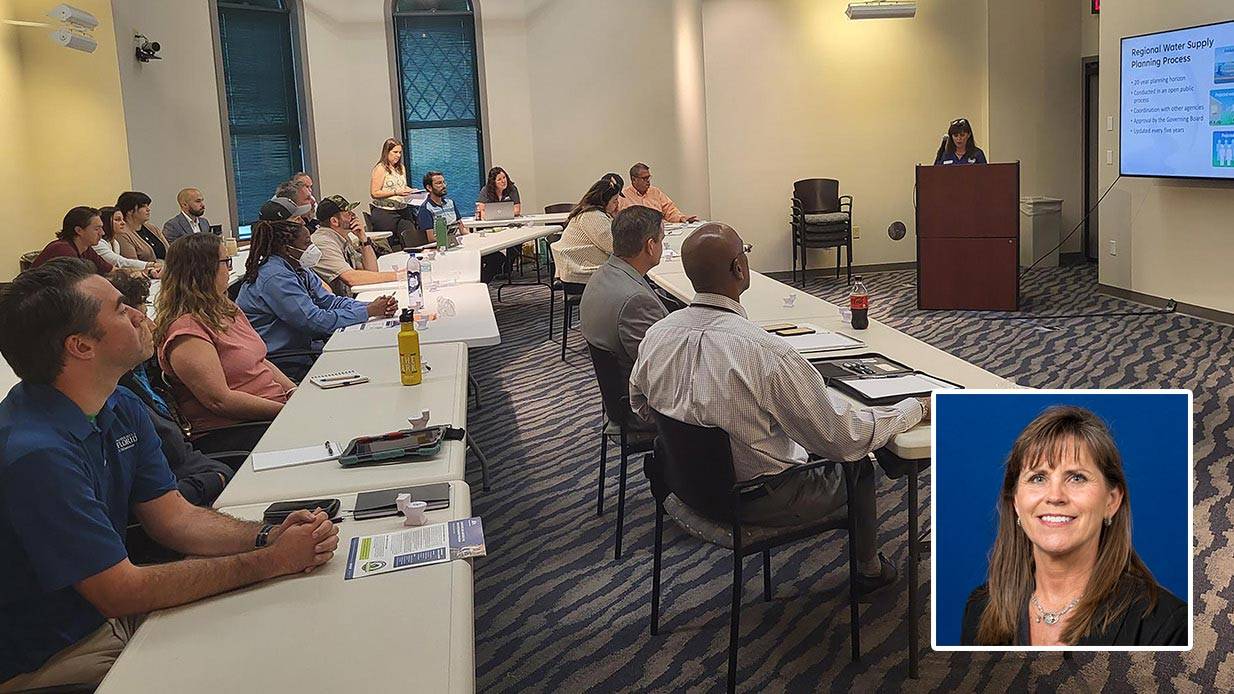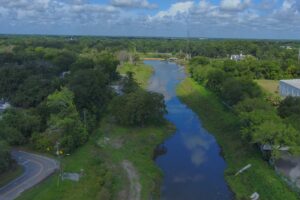Input from many people and groups will help shape region’s water supply plan
April 13, 2023
Lori Burklew (at podium and inset), water supply planning coordinator for the North Florida Regional Water Supply Partnership, shares about the planning process with utilities, local governments and others at a water conservation coordinators’ meeting hosted by JEA.
Just like a family plans and saves for a summer vacation, water managers are working with a variety of people across Florida to ensure a sustainable supply of drinking water.
While planning a family vacation might include gathering hotel or campground information and saving for meals and attraction entry fees, a water supply plan quantifies the needs for water, identifies where that water can come from and provides a list of project options to deliver that water in a way that will ensure people and the state’s waterways, plants and animals have the water they need.
“Florida has a robust and ongoing water supply planning process,” says Lori Burklew, regional water supply planning coordinator for the St. Johns River Water Management District’s north Florida region. “The process of gathering and interpreting data and involving residents and leaders in our communities is like drawing a roadmap. All the input helps build a solid plan to help meet our water supply needs, now and for the future.”
Behind the scenes, these topics and more are part of the planning work currently being conducted by staff at the St. Johns River and Suwannee River water management districts to prepare the five-year update to the 2015–2035 North Florida Regional Water Supply Plan.
“We want to ensure we are giving Florida residents, policy makers, local government utilities and other stakeholders an opportunity to be involved in the planning process to ensure a sustainable supply of water to meet all needs,” says St. Johns River Water Management District Executive Director Mike Register.
“Sometimes it is easy for us to take water for granted, as access to it is as simple as turning on the faucet,” says Hugh Thomas, executive director of the Suwannee River Water Management District. “But there is significant planning that goes into ensuring an adequate water supply to meet future demands while continuing to sustain our local water resources and natural systems.”
All the input helps build a solid plan to help meet our water supply needs, now and for the future.
Preparing a water supply plan is a complex and lengthy process. On average, it takes two to three years to gather and analyze data that go into helping District staff make the informed, science-based decisions that are laid out in these plans. Each time the team begins work on a plan or update, they gather a wealth of information, such as the latest population figures, water use numbers, environmental data, groundwater and surface water modeling results, and more. Throughout the process, staff work with neighboring water management districts, other state agencies, local governments and utilities, the agricultural community, and other stakeholders to evaluate this information.
Earlier in the current planning process, the Districts held technical workshops in November 2021 and reviewed comments on the scientific methods used to update population and water demand projections. Likewise, staff have incorporated updates to methods and datasets used to develop the population, water demand and water reuse projections, and the water conservation scenarios that are part of the updated plan. Late last year, in November 2022, the Districts held constraint assessment workshops and reviewed comments on the methods and results used to determine the effects of the plan on water users and related natural systems. The Districts are currently working with utilities, local governments, and other stakeholders seeking water supply project options to help meet our demands for water while protecting Florida’s unique environment. Project options are being accepted through April 28, 2023, to be considered in this five-year plan update.
Gathered input will be included in the draft 2020–2045 water supply plan, which will be available for public review in summer 2023. Find more information on this effort on the Partnership website at www.northfloridawater.com/watersupplyplan/index.html. The website includes information on how to submit a project option.
The water supply planning process began in Florida in 1996 when then-Gov. Lawton Chiles signed an executive order requiring development of 20-year plans to address water needs in the state. The Regional Water Supply Planning law was passed by the Legislature in 1997 and has been updated over the years. A collaborative statewide planning group created a guidance document that provides consistency while allowing plans to be tailored to the local regions and the conditions found there.
Florida is seeing unprecedented growth — recent estimates show approximately 1,000 people moving into our state on a daily basis. As the state continues to grow, plans must be made to ensure freshwater resources meet these growing demands, not just for today, but as far as 20 years into the future as well.
All of this must be done while protecting and sustaining our natural resources. The most effective way of addressing this challenge is through water supply planning.






